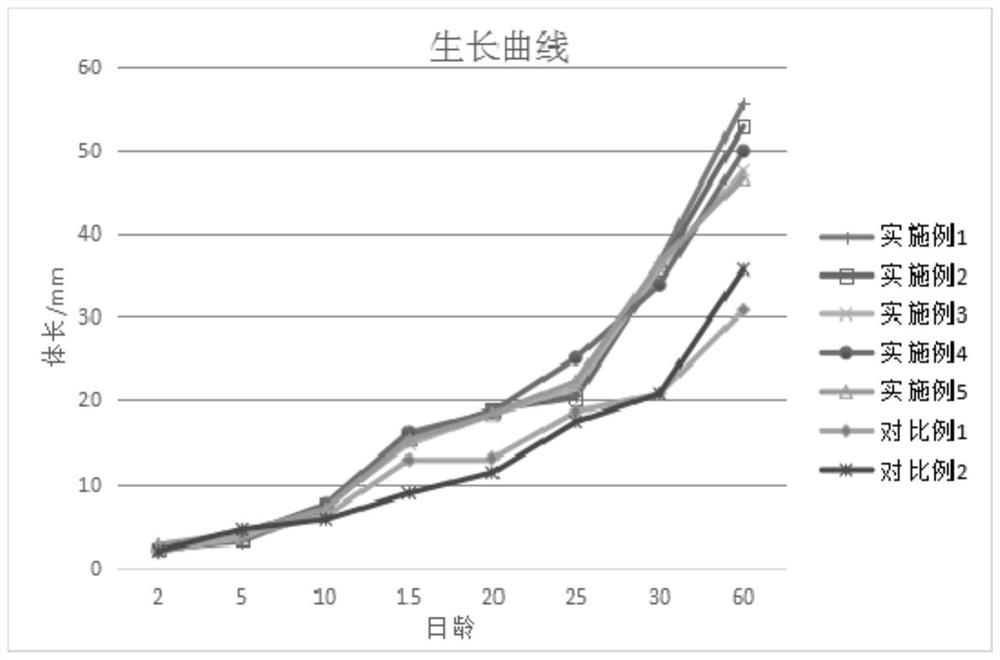High-survival-rate and high-growth-rate artificial breeding method for acanthopagrus latus
A technology for the survival rate of yellow-finned sea bream, which is applied in the field of fish farming, can solve the problems of slow growth rate, difficulty in meeting artificial breeding, and narrow suitable temperature for juvenile fish, and achieves the effect of increasing the growth rate.
- Summary
- Abstract
- Description
- Claims
- Application Information
AI Technical Summary
Problems solved by technology
Method used
Image
Examples
Embodiment 1
[0037] A method for artificial breeding of yellowfin roughy seabream with high survival rate and high growth rate, comprising:
[0038] 1) Select nursery ponds: add chlorella to indoor cement ponds, and keep the density of chlorella in water at 40×10 4 ~50×10 4 a / mL;
[0039] 2) Budding seedlings: put in the newly hatched larvae, and the breeding density of the newly hatched larvae is 30,000 fish / m 3 ;
[0040] 3) Regulate environmental factors during seedling cultivation:
[0041] Larvae 3-15 days old, pH 6.5-6.8; 16-60 days old, pH 8.2-8.5;
[0042] During seedling cultivation, keep the salinity at 25-30‰, the water temperature at 15-25°C, and the dissolved oxygen in the water is greater than 5mg / L;
[0043] Change the water every day, 20-30% of the water before the age of 20 days, and 50-60% of the water at the age of 20-60 days.
[0044] 4) Feeding:
[0045] The larvae were not fed before the age of 3 days, and the larvae were fed at the age of 3 days. Feeding stan...
Embodiment 2
[0051] A method for artificial breeding of yellowfin roughy seabream with high survival rate and high growth rate, comprising:
[0052] 1) Select nursery ponds: add chlorella to indoor cement ponds, and keep the density of chlorella in water at 40×10 4 ~50×10 4 a / mL;
[0053]2) Budding seedlings: put in the newly hatched larvae, and the breeding density of the newly hatched larvae is 30,000 fish / m 3 ;
[0054] 3) Regulate environmental factors during seedling cultivation:
[0055] Larvae 3-15 days old, pH 6.5-6.8; 16-60 days old, pH 8.2-8.5;
[0056] During seedling cultivation, keep the salinity at 25-30‰, the water temperature at 15-25°C, and the dissolved oxygen in the water is greater than 5mg / L;
[0057] Change the water every day, 20-30% of the water before the age of 20 days, and 50-60% of the water at the age of 20-60 days.
[0058] 4) Feeding:
[0059] There is no need to feed the larvae before the age of 3 days, and the larvae start to be fed with bait or arti...
Embodiment 3
[0065] A method for artificial breeding of yellowfin roughy seabream with high survival rate and high growth rate, comprising:
[0066] 1) Select nursery ponds: add chlorella to indoor cement ponds, and keep the density of chlorella in water at 40×10 4 ~50×10 4 a / mL;
[0067] 2) Budding seedlings: put in the newly hatched larvae, and the breeding density of the newly hatched larvae is 30,000 fish / m 3 ;
[0068] 3) Regulate environmental factors during seedling cultivation:
[0069] Larvae 3-15 days old, pH 6.5-6.8; 16-60 days old, pH 8.2-8.5;
[0070] During seedling cultivation, keep the salinity at 25-30‰, the water temperature at 15-25°C, and the dissolved oxygen in the water is greater than 5mg / L;
[0071] Change the water every day, 20-30% of the water before the age of 20 days, and 50-60% of the water at the age of 20-60 days.
[0072] 4) Feeding:
[0073] There is no need to feed the larvae before the age of 3 days, and the larvae start to be fed with bait or art...
PUM
 Login to View More
Login to View More Abstract
Description
Claims
Application Information
 Login to View More
Login to View More - R&D
- Intellectual Property
- Life Sciences
- Materials
- Tech Scout
- Unparalleled Data Quality
- Higher Quality Content
- 60% Fewer Hallucinations
Browse by: Latest US Patents, China's latest patents, Technical Efficacy Thesaurus, Application Domain, Technology Topic, Popular Technical Reports.
© 2025 PatSnap. All rights reserved.Legal|Privacy policy|Modern Slavery Act Transparency Statement|Sitemap|About US| Contact US: help@patsnap.com

